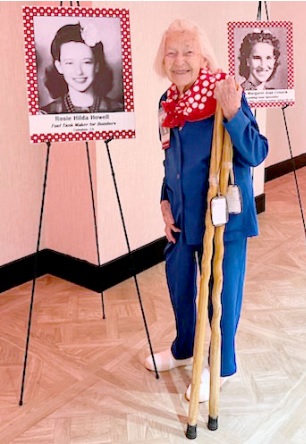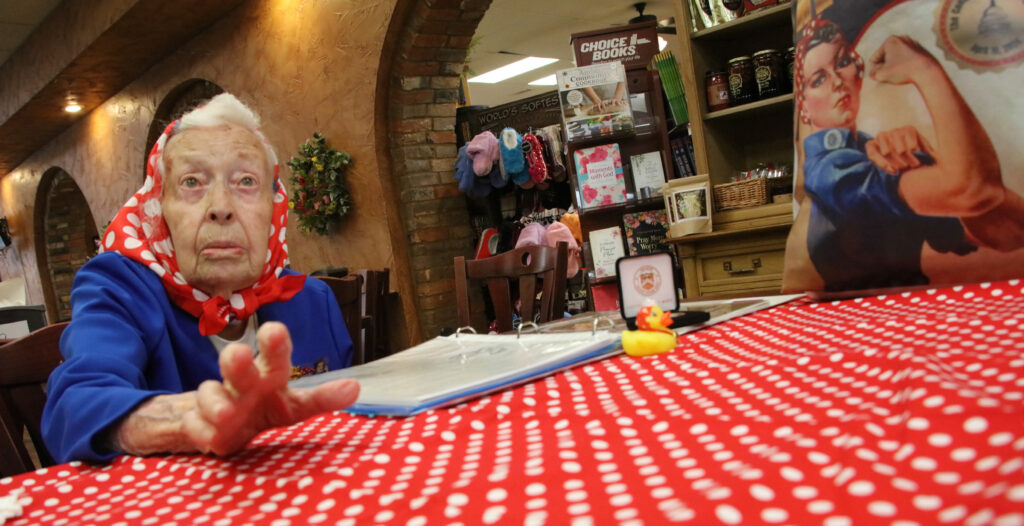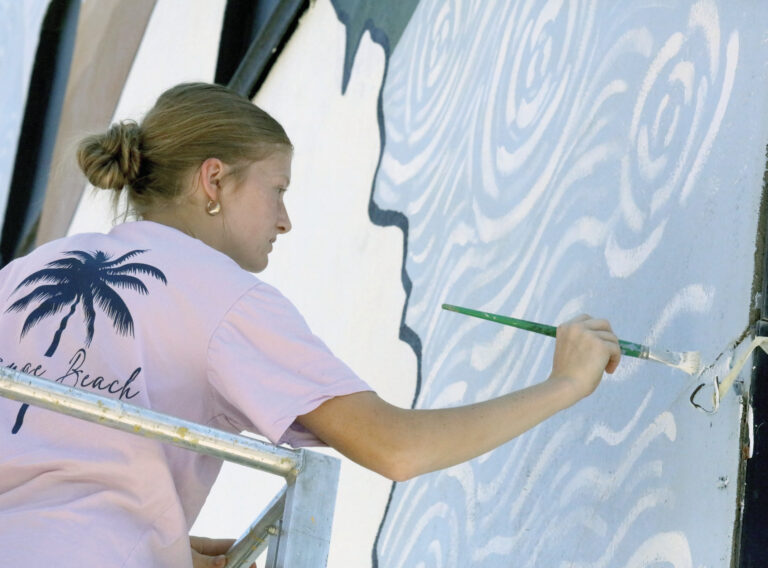Women on the Home Front

Local ‘Rosie the Riveter’ honored in D.C.



By Sheila Harris sheilaharrisads@gmail.com
“Rosie,” she was called — short for Rosie the Riveter.
The iconic name, memorialized by the equally iconic Howard Miller image of a young woman flexing an arm muscle, while sporting a red and white polka-dotted bandana on her head, and including the words, “We can do it,” above her head, refers collectively, to some 6 million women who entered the U.S. industrial workforce during World War II to perform jobs traditionally filled by men.
Most of the women manufactured aircraft, munitions and supplies necessary to the war effort, with their work fueled by necessity and an eager spirit of patriotism.
Hilda Campbell Howell, who lives with her daughter and son-in-law, Gwen and Dennis Kelley, in Barry County’s historic Corsicana community, is among their still-living, rapidly-dwindling numbers.
Accompanied by her daughter, Howell recently traveled to Washington, D.C., for a special ceremony, on April 10, where the Congressional Gold Medal was presented collectively to Rosie the Riveters in honor of the group’s World War II service. In addition to the collective medal, the 27 members of the American Rosie the Riveter Association (ARRA) who were able to make the trip to D.C. were presented with individual, newly minted Rosie the Riveter commemorative coins.
Howell was the only Rosie from Missouri in attendance, and she is perhaps the only one from the state still living.
Petite, white-haired and 97-year-old, Howell is an avid reader who speaks softly and carries two oversized sticks: polished cedar walking sticks that she picked up at a Love’s truck stop and, for ambulatory assistance, prefers over the more traditional walker. No matter what she uses to walk, she is able to recount with great clarity her remarkable World War II memories from her adolescence spent in southern California.
Hilda Howell Campbell — as she was known then — was the fourth of five children in the Campbell family, who lived in a rural area near Compton, Calif., not far south of Los Angeles, when the United States entered World War II.
“My father wasn’t in the service, but he was in great demand on the home front because of his engineering knowledge,” said Howell, whose family moved eight times during her childhood to follow her father’s work with road and railroad construction crews.
“My dad believed if [kids] were old enough to feed themselves, they were old enough to work,” said Howell, whose two older brothers, Granville and Robert, and, later, her younger brother, Wilfred, entered military service. Her older sister, Margaret, joined the workforce as what later became known as a “Rosie.”
“During the war, my mom raised chickens and rabbits and a victory garden,” Howell said. “Plus, we had a dairy farm. We supplied a few restaurants in the area, and, a lot of times, we’d have people come to our house and ask if they could buy food. My mom put me in charge of those sales, and, until I knew better, I tried to provide only the amount of food that people paid for. Later, though, my grandma told me that people only paid what they could afford, and that maybe I shouldn’t use that as my standard.”
As soon as she was old enough, Howell joined the workforce, part time, at Compton Junior College, where Firestone had established a site to manufacture fuel cells for bombers.
“Kids from several high schools in the area rode buses to go to work in the facility,” said Howell, who was in her late teens at the time. “There were fewer than 100 of us working there.”
Howell looked at the job not only as a way to make money, but to serve her country at the same time.
“I worked about four hours every day, after school, sealing the rubber on the inside of aircraft fuel tanks, using a little wooden roller to get all the bubbles out,” she said.
Howell said the work, which paid 26 cents an hour, was dirty.
“My clothes and hands would be black from the rubber, every night,” she said.
Howell said she would often forego her study hall hour at school so she could put more time in for Firestone.
According to the history of Firestone in World War II, the company established 13 such manufacturing sites in the United States and one in Canada, where they manufactured some 600,000 fuels cells for nine different types of aircraft, including B-17 and B-29 bombers.
Tangential to Howell’s aircraft work, the night of Feb. 24, 1942, later known as the “Battle of Los Angeles,” stands out in her adolescent memories.
“We’d been under blackouts and curfews for a long time by then, so when we heard airplanes coming in overhead, one after the other, we knew something was up,” she said. “There wasn’t supposed to be anything like that going on.”
Howell says she and her brother ran outside to look up at the sky, but when she heard bullets whizzing through the air, she didn’t stay long.
“I ran back inside the house to pray,” she said.
Citizens along the west coast took the U.S. Secretary of War’s warning seriously when, after the bombing of Pearl Harbor, he said that American cities should be prepared to accept “occasional blows” from its enemies. One blow came off the coast of Santa Barbara on Feb. 23, when a Japanese submarine surfaced and lobbed a dozen artillery shells at an oil field and refinery.
Although no one was injured and damage was minimal, nerves were on edge the following night, when, whether real or imagined, Japanese fighter planes were spotted over Los Angeles.
In response to the perceived threat, American anti-aircraft fire filled the skies over the city around 3 a.m. and continued until dawn. The so-called “friendly fire” resulted in property damage and the deaths of five California residents: four from cardiac arrest and one from a car accident.
In addition to the Battle of L.A., the bombing of Pearl Harbor resulted in the signing of Executive Order 9066 by President Franklin D. Roosevelt, on Feb. 19, 1942. The order authorized the internment of some 120,000 Japanese-American residents to designated containment camps in isolated areas of the country. Some of those subjected to the mandate had as little as 1/16 Japanese heritage; the majority were U.S. citizens. Executive Order 9066’s stated purpose was to prevent espionage on American shores.
“I had a Japanese friend at the time, a girl my age who I did things with on a regular basis,” Howell said “They sent an official to our house after the Japanese were rounded up. When I answered the door, he asked me if my mother was home. After I got my mother, he told both of us that my friend had been taken away and that I wouldn’t be seeing her again.”
As Howell recalled that moment in her personal life, played out within the larger framework of the nation’s WWII history, her voice was devoid of the emotion she once must have felt. Over the years, calm reflection has taken its place.
In addition to her own memories, Howell shared a story in honor of her older brother, Granville, who’s no longer alive to tell it himself.
“During the war, women around the country began operating canteens, where they served food for servicemen,” she said.
While Nebraska’s North Platte Canteen was the nation’s first and longest- running establishment, at New York City’s Stage Door Canteen and at the Hollywood Canteen in Los Angeles, stars stepped up to serve and entertain servicemen and women.
“Granville met a young girl there, about my age, who asked him to escort her back to her hotel,” Howell said. “He said she looked familiar, but she wouldn’t tell him her name. ‘I’ll tell you when we get to my place,’ she told him. When my brother delivered her to her door, she pulled out an I.D. card and, as promised, revealed her name. ‘She was Shirley Temple,’ Granville later told us.”
After Howell’s high school graduation, her work for Firestone ended, but she continued her work in the war effort as a filing clerk for the Red Cross.
At war’s end in 1945, Howell rejoiced along with the rest of the nation as the men came home. Among them was a young flight engineer named Harreld Howell, a friend of the son of the woman who helped Howell’s mother on the family’s dairy farm.
Howell and Harreld fell head over heels for each other and wed the following year. They afterward moved to Harreld’s hometown of Oklahoma City, where his mother had set up shop as the city’s first female pharmacist after his father died. The newlywed Howells later had two children: Gwen, and her older brother, Kenneth.
After Harreld’s passing in 2012, Howell moved into her daughter Gwen’s and son-in-law Dennis Kelley’s rural Barry County home, not far from the Ozarks town of Hollister, where Howell’s own mother had roots.
As with many of the women who became known as Rosie the Riveter, Howell says she did what needed to be done at the time. In so doing, she helped fill a sorely-felt gap on the home front while men were fighting battles overseas.
Over past years, Rosies Mae Krier and Phyllis Gould advocated tirelessly for United States Congress to recognize the contributions of women during World War II. The 2024 Congressional Gold Medal – often called “the highest civilian honor” bestowed by the U.S. government – is, in part, a result of their hard work, although Gould wasn’t alive to see it brought to fruition. She passed away in 2021.
Krier and Gould were joined in their Rosie the Riveter lobbying efforts about 12 years ago by now-22-year-old Raya Kennedy, of Washington, D.C., whose grandmother was a Rosie. Inspired by the story of the Rosies at a young age, Kennedy now heads up a drive to establish a monument in their honor at the nation’s capital.
Also instrumental in the Rosies’ receipt of the congressional medal was the Rosie the Riveter Home Front Park, established in 2000 in Richmond, Calif., on land donated by Kaiser Shipyards, where 747 ships were constructed during World War II. The park’s non-profit partner, Rosie the Riveter Trust, provided funding for the Rosies’ trip to Washington, D.C., where they were joined by Home Front Park superintendent, K. Lynn Berry.
Sponsors for the gala award ceremony included The Gary Sinise Foundation; Boeing Company; International Brotherhood of Boilermakers, Local 549 and Local 92; Kaiser Permanente; Northrop Grumman; and United & CSX.


